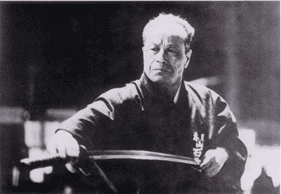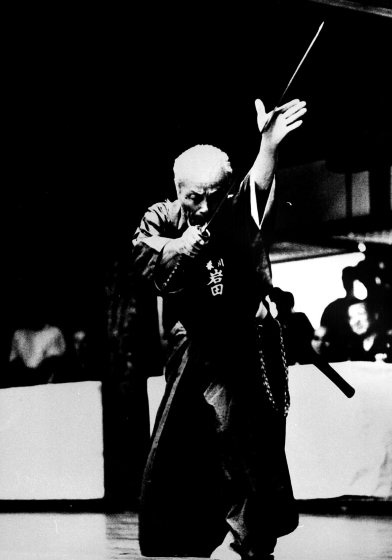| First Section | Second Section | Third Section |

MENTAL AND PHYSICAL PREPARATION MUST BE TOTALLY SUSTAINED ALL THROUGH PRACTICE OR DEMONSTRATIONS
 |
This is why movement/actions are carried through quietly and gracefully. For example, when taking Noto action, the moment the Kissaki comes into contact with the Koikuchi, the blade appears to stop. This is because a continuation of Noto action must be Zanshin. Lately I have seen many people perform Noto too quickly and without care. They may consider that faster is better. I feel rather sad about this. I can't see any Zanshin or spirit in forms that are done fast by people. If in actual fact there was an opponent in front of them, they would surely have to move with care. I still repute that Oh-e Sensei performed embu with a spirit of Zanshin towards an invisible opponent. Amid performing so many techniques, concentration is obviously important. Although, it might be over anxious to hold this attitude all the way through a form. One must find the most important points and concentrate on them with spiritual intention. We have to learn how to relax between actions. One can learn how to use power by studying The Book of the Five Elements. This is not an easy book for beginners to understand, but it will become more effortless through repetitive practice. |
IN MY OPINION OH-E SENSEI USED FEW IMPORTANT TECHNICAL POINTS FROM THE SHIMOMURA HA.
Eishin Ryu Shimomura Ha (Known as Muso Shinden Ryu) was created by Shimomura Moichi and passed on to the 15th Sub-Master Yukimune Sadayoshi. Then next onto the 16th Master Soda Torahiko., Then Kususe Yoh-ho living in Kochi Ken (Prefecture) on Shikoku Island. As I stated before Oh-e Sensei was the original 15th Master of this school. Therefore he must have known everything about the details of it.
PECULIARITIES OF THE SHIMOMURA HA :
A) Twisting the Saya round to the rear.
B) When taking Noto action, the left hand must grip the Koikuchi in the reverse manner, then following two more actions must be removed at the same time as;
Action 1. Putting the Kissaki in the Koikuchi.
Action 2. Pulling the left foot forward.
C) The general posture at this stage seems to be a little diagonal because of the left hand control.
D) This is probably why the left foot is pulled forward. To correct the body posture and square it up to take Furikaburi action.
E) The root of both Shimomura Ha (Shinden) and Tanimura Ha (Jikiden) is the same. So we cannot find drastic differences. Although we can find a few noticeable movements. For example ; Oroshi (5th Form Tatehiza). When striking the opponent in Mizo-uchi, Metsuke is towards the eyes of the opponent. The left hand uses the Tsukagashira gripping the Saya from the underside.
F) The pulling down action - Hiki Taoshi in Ukigumo (4th Form Tatehiza) is performed by using the sword edge in a vertical manner, cutting downward and pulling the sword towards ones own body. However because of this action the shoulders become rather tight. Therefore one must immediately swing up the sword and cut the opponent to complete the action.
G) Bringing the feet together in Chiburui is no different. Above are a few noticeable points, but basically not much of a difference. As stated earlier Shimomura Ha has more hand and finger techniques.
TECHNICAL VARIATION IN THE METHODS OF OH-E SENSEI
His procedure before starting movements was to concentrate his mind on the opponent with full fighting spirit. However unfortunately the majority of young practitioners are performing in a way which looks pretty and facetious.
Perhaps they are aiming to win a Competition or attain a higher Dan- grade. I find it rather lamentable. However it could be a natural occurrence as generations change.
So saying;
(1) People change the system to perform an easier Embu rather than a fundamental/logical performance.
(2) Actions such as Kiru (cutting), Tsuku (thrusts), Hiki-taosu (cutting and pulling down) are performed to look smart and end up looking bizarre rather than having the original basic performing attitude. (1) and (2) create the following problems;
(a) In Furikaburi the Kissaki is higher than head level.
(b) Kirioroshi (Kiritsuke) is the same as making a circular motion as in Furikaburi action. But these days the sword seems to be brought straight up above the head.
(c) Ignoring the proper usage of the stomach and hips.
(d) Also the lack of concentration of; (1) Twisting the body. (2) Turning the body. (3) Kamae using the whole body. (e) Performing Kiru (cuts), Tsuku (thrusts), Hiki-taosu (pull downs) sharply.
(f) The sword is kept motionless during actions.
On the whole I think that style is altering as generations change. Especially since SEITEI IAI has been created and introduced, clear differences have become very inept. As a result, some students (practitioners) have come to chose one of the classic styles or a new style. This is unfortunately is now a reality. Also Seitei Iai has become more important because of its requirement for modern day competitions and grading. The preservation of the classical styles is becoming eminently more difficult.
My teacher Mori Shigeki Sensei told me that even Oh-e Sensei used to say, Techniques are changing rapidly these days. Mori Sensei had resolved to write a book about the style of Oh-e Sensei with the co-operation of the 18th Master Hokiyama Namio. Unfortunately this plan had to be cancelled due to Hokiyama Sensei passing away.
As changes in style, attitude and techniques were already noticeable in the lifetime of Oh-e Sensei, he was worried and concerned. He thought that it was becoming too easy, too fast, overly convenient and looking flash. This was against Oh-e Sensei’s basic methods. However his attitudes towards this were not negative. He sometimes gave encouragement to newly created Kae-waza and Henka-waza (rearranged technique). One of my teachers Yamamoto Takuji Sensei told me that Oh-e Sensei’s student Takemura Shizuo Sensei used to practice every day. He often asked Yamamoto Sensei to look at his rearranged techniques. He created techniques for twisting around and turning the body. The Sode-suri-gaeshi of Yamamoto Harusuke Sensei (7th form Oku Iai Tachiwaza) is influenced by Takemura Sensei and differs from the method of Oh-e Sensei.
IT IS IMPORTANT TO FOLLOW THE METHODS OF OH-E SENSEI.
Our generation feels genuinely proud in being able to have received tuition from the lineal students of Master Oh-e. However, some of his students told me that after being led by Oh-e Sensei on a one week seminar they were very fortunate and proud of the experience. They felt as if they were already students of Oh-e Sensei. This kind of comment gives us cause for concern, as people with little experience can easily initiate shallow and poor technique. His life spanned the Meiji, Taisho and Showa eras. It is impossible to pick up his experience and technique in a week or two.
An important point that we have to keep in mind is to understand that the students of Oh-e Sensei are branches of his original school. It does not matter how much they try to follow and obey his original method and techniques, they are all human beings. Therefore a students performance tends to differ from the original.
Major and important points were written in the books Muso Jikiden Eishin Ryu Iaido by the 18th Master Hokiyama and Muso Jikiden Eishin Iaido Zukan, (Pictorial) By the 20th Master Kono Hyakuren. However the person who respected the technique and methods of Oh-e Sensei was my teacher Yamamoto Takuji Sensei.